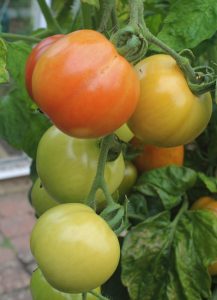Now that the weather is starting become distinctly autumnal, it’s time to pick your last tomatoes and ripen them on the windowsill or greenhouse.
Some green, blemish free fruit can be stored in a cool drawer, to be ripened in the fruit-bowl or in a paper bag with an over ripe banana, as needed during the winter. Check stored tomatoes regularly, as you would your apples, removing any showing signs of decay and make sure there is a good gap between the fruit and that they are not touching each other. After picking for the final time, lift and compost your tomato plants, weed through the greenhouse removing any debris and if it is pest and disease free, add it to the compost heap. You can also bring outdoor tomatoes into the greenhouse to ripen.
Tender plants can be stored under the greenhouse benches, bringing in before the first frosts; they will welcome the added protection. Cut back foliage on plants like pelargoniums to save space. Ventilate the greenhouse on sunny days, shutting the windows by the middle of the afternoon to capture the warm air, so it cools down slowly as the day draws on.

Dahlia tubers are often overwintered outdoors in warmer areas, though it’s worth bearing in mind there is always a risk of a ‘one off’ winter that is harder than normal and in colder climates tubers of tender plants like Dahlias and Cannas should definitely be lifted and stored in a cool frost-free place. Once the first frosts have blackened the foliage, cut back the stems to within 5cm of the base. Make sure the labels stay with the tubers, turn them upside down on the greenhouse bench for a few weeks, so water drains from the hollow stems, then turn them upright and store them in trays, covering the tubers covered in a thick layer of compost for protection – spent compost from hanging baskets and containers is ideal.
Sow sweet peas indoors from October into November. Soften the seed coat by putting the seeds on a layer of kitchen towel on a dinner plate, put another layer on top. Dampen the towel, drain off excess water and sow as soon as they begin to swell or sprout, usually after about 48 hours. Those that don’t swell and germinate can be composted. Sow the living seeds individually into ‘Root Trainers’ or 9cm (3in) pots of seed compost or five to seven seeds to a 13cm (5in) pot, with the seeds spaced 2-3cm (¾-1¼in) apart, then cover the seeds with 1cm (½in) of compost. Water in gently, cover the pots with clear polythene then put them in a propagator or warm room at about 15°C (59°F). Remove the covering after they have germinated and overwinter the young plants in a cold frame or unheated greenhouse. If not sown individually, transplant single seedlings into 9cm (3in) pots once they have reached about 3.5 cm (1½in)
Lift pots and remove and dispose of slugs that are hiding underneath and check over your stored greenhouse plants regularly, removing yellowing or dead leaves and faded flowers before rots develop. Remove and compost any dead foliage affected by red spider mite or summer greenhouse pests in your council green bin. Happy gardening. Matt










